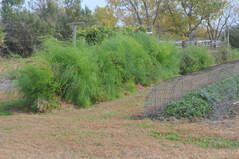 Harvest is long past but now is the time asparagus and rhubarb plants build up needed reserves for the next year. Be sure to water during dry weather and keep plants free of weeds. Rhubarb should not be fertilized now but in early spring (March). Do not fertilize asparagus now or in early spring but rather wait until after harvest next year. Asparagus foliage should be left until all green is gone. It can then be removed or left for the winter to help collect snow. (Ward Upham) 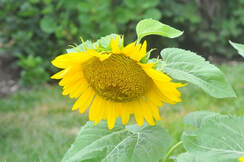 Sunflowers are usually ready to be harvested beginning in mid-September and into October. Seed heads can ripen on the plant, but they will need protection from birds. Try covering the heads with a paper sack or cheesecloth once the petals start turning brown. Use a twist tie or rubber band to secure the covering. This will not only help keep birds out but will prevent ripened seeds from dropping out of the head. Check for maturity by looking for the following signs: – Florets in the brown center of the flower disk should be shriveled. – Heads should have turned down. – The backside of the head should be lemon yellow. The ultimate check, of course, is to pull a few seeds to see if they have turned black with white stripes, the typical color. Empty shells usually indicate a lack of pollination earlier in the year. If heads are to remain uncovered, harvest when a few seeds start turning black and white. The flavor will not be good as when seeds are allowed to ripen on the plants, but fewer seeds will be lost. Cut the heads and place in a paper sack. Some people prefer to cut the heads with about a foot of stem attached and hang them upside down in a dry, well-ventilated area. A paper bag or cheesecloth can be placed over the heads to prevent seeds from dropping as they dry. Seeds can be easily removed from dry heads by rubbing gently. Roasting Seeds Raw, mature seeds may be prepared at home by covering unshelled seeds with salted water (2 quarts of water to 1/4 to 2 cup salt). Bring to a boil and simmer 2 hours, or soak in the salt solution overnight. Drain and dry on absorbent paper. Put sunflower seeds in a shallow pan in a 300-degree F oven for 30 to 40 minutes or until golden brown, stirring occasionally. Take seeds out of the oven and add 1 teaspoon of melted butter or margarine, or cooking oil per 1 cup of seeds if they are to be eaten immediately. Stir to coat. Put on an absorbent towel. Salt to taste. (Ward Upham) 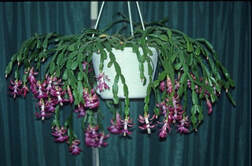 Christmas Cactus (Schlumbergera bridgesii) and Thanksgiving Cactus (Schlumbergera truncate) are popular flowering holiday plants. Both are epiphytes native to the jungles of South America. Epiphytic plants grow on other plants and use them for support but not for nutrients. Though these cacti are different species, they will hybridize and produce varying stem shapes. Christmas cactus normally has smooth stem segments. Thanksgiving Cactus has hook-like appendages on each segment. Flowering will not occur unless induced by temperature and light treatment. If the temperature is held at 50 to 55 degrees F, flowering will occur regardless of day length. But flowering usually is not uniform. Temperatures below 50 degrees F prevent flowering. Nights greater than 12 hours long and temperatures between 59 and 69 degrees also can generate flowers. Twenty-five consecutive long nights is enough for flower initiation. Nights will naturally become greater than 12 hours close to the fall equinox, which is on September 22 this year. A plant receiving natural sunlight but no artificial light during night hours, will have this 25-day requirement met about October 17. Alternatively, plants can be placed in a dark place such as a closet for over 12 hours each day to induce flowering. It takes an additional nine to 10 weeks for flowers to complete development and bloom. Both of these cacti like bright indirect light during the day. Too much sun may cause leaves to turn yellow. Common household temperatures are fine. Keep soil constantly moist but not waterlogged. These plants seem to flower best if kept a little pot bound. If you need to repot, try waiting until spring. (Ward Upham) 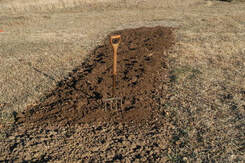 Many gardeners make compost without understanding how to use it around the home. Compost has a number of horticultural applications which are described below. Fertilization and soil improvement. Organic materials can be added to improve soil looseness and workability. Heavy, tight clay soils benefit from the loosening effects of composted organic materials. In sandy soils, organic material acts as a sponge to hold water and nutrients. Compost contains nutrients plants require. The amount of specific nutrients depends on the types of materials composted and how much water the pile contains. The suggested application rate is 50 to 100 pounds per 100 square feet, which is about ¼ inch of material spread over the entire garden. The best time to apply compost is just before tillage in either the spring or fall to incorporate the compost throughout the root zone. In Kansas, garden soils are often tilled in the fall. Compost made early in the season should be ready by then, or use last year’s compost if you have a two-pile system. Compost at planting. Apply a band of compost in the bottom of a row trench or add several shovels full to the bottom of planting holes. Tomato plants, perennial flowers, trees, and shrubs benefit from the slow release of nutrients through the early growth period. Compost can be applied as a top dressing for seeded vegetables and flowers to prevent soil crusting. It can be used as a substitute for soluble fertilizer or starter solution when mixed in equal parts with water. Leftover compost can be added to garden soil later. Potting mix for seedlings. Compost that has been screened for large particles can be mixed with soil or sand in approximately equal parts, and then used as a growing medium. To ensure healthy seedlings, compost should be well deteriorated and free of harmful disease organisms and insects. Using compost on a lawn. The best way to use compost is to apply it liberally before planting. Fertilize by adding a thin layer of top dressing every year. (Ward Upham) 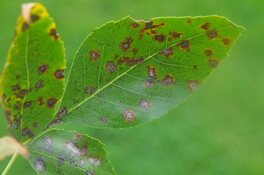 With all the concern about Emerald Ash Borer (EAB), many people may assume that any ash tree with problems is being attacked by EAB. However, EAB has only been confirmed in Atchison, Doniphan, Douglas, Jackson, Jefferson, Johnson, Leavenworth, Miami, Shawnee & Wyandotte counties. One of the other problems we see with ash is Mycosphaerella Leaf Spot. Though this disease looks serious, it is not. Mycosphaerella Leaf Spot causes small, brown spots that enlarge to become blotches and may result in early leaf drop. This disease can be severe enough to cause complete defoliation of the tree. However, defoliation this late in the growing season will not hurt the health of the tree. Therefore, because this disease appears sporadically and tree health is not harmed, we do not recommend treatment. Furthermore, treatment would have to be preventative and applied before the disease had infected the leaves. Applying a fungicide now would have no effect. (Ward Upham) 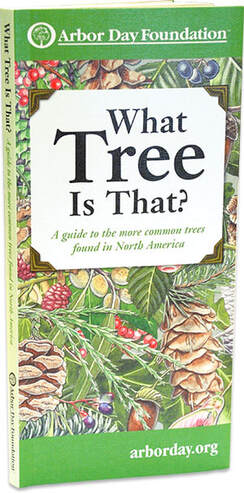 If you need a simple tree identification key, consider the “What Tree is That?” from the Arbor Day Foundation. Even though it is a bit over 150 pages, the booklet is small enough to fit in your pocket, yet covers many of the trees found in Kansas. The guide uses a step-by-step approach for identification that is perfect for those who are unfamiliar with the technical names of plant parts. Full color botanical illustrations are also helpful. More information can be found at http://www.arborday.org/trees/whatTree/ (Ward Upham) 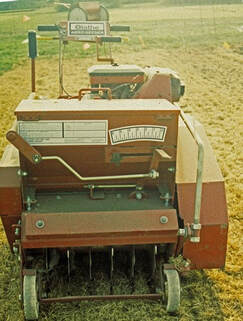 The keys to successful lawn seeding are proper rates, even dispersal, good seed to soil contact, and proper watering. Evenness is best achieved by carefully calibrating the seeder or by adjusting the seeder to a low setting and making several passes to ensure even distribution. Seeding a little on the heavy side with close overlapping is better than missing areas altogether, especially for the bunch-type tall fescue, which does not spread. Multiple seeder passes in opposite directions should help avoid this problem. A more serious error in seeding is using the improper rate. For tall fescue, aim for 6 to 8 pounds of seed per 1,000 square feet for new areas and about half as much for overseeding or seeding areas in the shade. Kentucky bluegrass is much smaller seed so less is needed for establishment. Use 2 to 3 pounds of seed per 1,000 square feet for a new lawn and half that for overseeding or shady areas. Using too much seed results in a lawn more prone to disease and damage from stress. The best way to avoid such a mistake is to determine the square footage of the yard first, and then calculate the amount of seed. Using too little seed can also be detrimental and result in clumpy turf that is not as visually pleasing. Establishing good seed to soil contact is essential for good germination rates. Slit seeders achieve good contact at the time of seeding by dropping seed directly behind the blade that slices a furrow into the soil. Packing wheels then follow to close the furrow. The same result can be accomplished by using a verticut before broadcasting the seed, and then verticutting in a different direction a second time. Core aerators can also be used to seed grass. Go over an area at least three times in different directions, and then broadcast the seed. Germination will occur in the aeration holes. Because those holes stay moister than a traditional seedbed, this method requires less watering. If the soil that has been worked by a rototiller, firm the soil with a roller or lawn tractor and use light hand raking to mix the seed into the soil. A leaf rake often works better than a garden rake because it mixes seed more shallowly. Water newly planted areas lightly, but often. Keep soil constantly moist but not waterlogged. During hot days, a new lawn may need to be watered three times a day. If watered less, germination will be slowed. Cool, calm days may require watering only every couple of days. As the grass plants come up, gradually decrease watering to once a week if there is no rain. Let the plants tell you when to water. If you can push the blades down and they don't spring back up quickly, the lawn needs water. Once seed sprouts, try to minimize traffic (foot, mower, dog, etc.) seeded areas receive until the seedlings are a little more robust and ready to be mowed. Begin mowing once seedlings reach 3 to 4 inches tall. (Ward Upham) 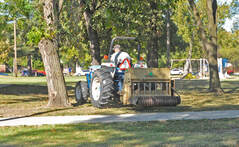 Tall fescue lawns that have become thin over the summer can be thickened up by overseeding during September. Start by mowing the grass short (1 to 1.5 inches) and removing the clippings. This will make it easier to achieve good seed-soil contact and increase the amount of light that will reach the young seedlings. Good seed-soil contact is vital if the overseeding is to be successful. Excess thatch can prevent seed from reaching the soil and germinating. Normally we want 1/4 inch of thatch or less when overseeding. If the thatch layer is 3/4 inch or more, it is usually easiest to use a sod cutter to remove it and start over with a new lawn. A power rake can be used to reduce a thatch layer that is less than 3/4 inch but more than a quarter inch. Once thatch is under control, the soil should be prepared for the seed. This can be done in various ways. For small spots, a hand rake can be used to roughen up the soil before the seed is applied. A verticut machine has solid vertical blades that can be set to cut furrows in the soil. It is best to go two different directions with the machine. A slit seeder is a verticut machine with a seed hopper added so the soil prep and seeding operation are combined. Another option is to use a core aerator. The core aerator will punch holes in the soil and deposit the soil cores on the surface of the ground. Each hole produces an excellent environment for seed germination and growth. Make three to four passes with the core aerator to ensure enough holes for the seed. Using a core aerator has the additional benefit of reducing the amount of watering needed to get the seed germinated and growing. Aeration also increases the water infiltration rate, decreases compaction, and increases the amount of oxygen in the soil. Of the three methods, I prefer the slit seeder for obtaining good seed/soil contact. However, if watering is difficult, core aeration may be a better option. Regardless of method used, fertilizer should be applied at the rate suggested by a soil test, or a starter fertilizer should be used at the rate suggested on the bag. (Ward Upham) |
AuthorsCynthia Domenghini runs the Horticulture Response Center in the Department of Horticulture and Natural Resources at Kansas State University. Other contributors include K-State Extension Specialists. Archives
March 2024
Categories
All
|
| K-State Research and Extension Horticulture Newsletter |
|
 RSS Feed
RSS Feed
